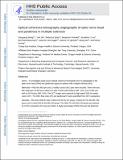Optical coherence tomography angiography of optic nerve head and parafovea in multiple sclerosis
Author(s)
Wang, Xiaogang; Jia, Yali; Spain, Rebecca; Potsaid, Benjamin M.; Liu, Jonathan Jaoshin; Baumann, Bernhard; Hornegger, Joachim; Fujimoto, James G.; Wu, Qiang; Huang, David; ... Show more Show less
DownloadFujimoto_Optical coherence.pdf (443.7Kb)
OPEN_ACCESS_POLICY
Open Access Policy
Creative Commons Attribution-Noncommercial-Share Alike
Terms of use
Metadata
Show full item recordAbstract
Aims To investigate swept-source optical coherence tomography (OCT) angiography in the optic nerve head (ONH) and parafoveal regions in patients with multiple sclerosis (MS).
Methods Fifty-two MS eyes and 21 healthy control (HC) eyes were included. There were two MS subgroups: 38 MS eyes without an optic neuritis (ON) history (MS −ON), and 14 MS eyes with an ON history (MS +ON). The OCT images were captured by high-speed 1050 nm swept-source OCT. The ONH flow index (FI) and parafoveal FI were quantified from OCT angiograms.
Results The mean ONH FI was 0.160±0.010 for the HC group, 0.156±0.017 for the MS−ON group, and 0.140±0.020 for the MS+ON group. The ONH FI of the MS+ON group was reduced by 12.5% compared to HC eyes (p=0.004). A higher percentage of MS+ON eyes had abnormal ONH FI compared to HC patients (43% vs 5%, p=0.01). Mean parafoveal FIs were 0.126±0.007, 0.127±0.010, and 0.129±0.005 for the HC, MS−ON, and MS +ON groups, respectively, and did not differ significantly among them. The coefficient of variation (CV) of intravisit repeatability and intervisit reproducibility were 1.03% and 4.53% for ONH FI, and 1.65% and 3.55% for parafoveal FI.
Conclusions Based on OCT angiography, the FI measurement is feasible, highly repeatable and reproducible, and it is suitable for clinical measurement of ONH and parafoveal perfusion. The ONH FI may be useful in detecting damage from ON and quantifying its severity.
Date issued
2014-05Department
Massachusetts Institute of Technology. Department of Electrical Engineering and Computer Science; Massachusetts Institute of Technology. Research Laboratory of ElectronicsJournal
British Journal of Ophthalmology
Publisher
BMJ Publishing Group
Citation
Wang, X., Y. Jia, R. Spain, B. Potsaid, J. J. Liu, B. Baumann, J. Hornegger, J. G. Fujimoto, Q. Wu, and D. Huang. “Optical Coherence Tomography Angiography of Optic Nerve Head and Parafovea in Multiple Sclerosis.” British Journal of Ophthalmology 98, no. 10 (May 15, 2014): 1368–1373.
Version: Author's final manuscript
ISSN
0007-1161